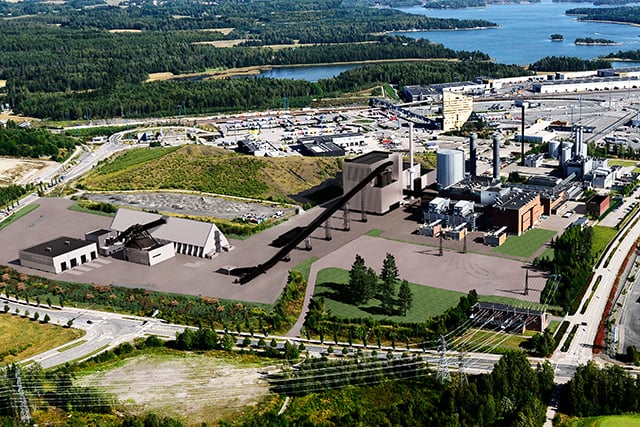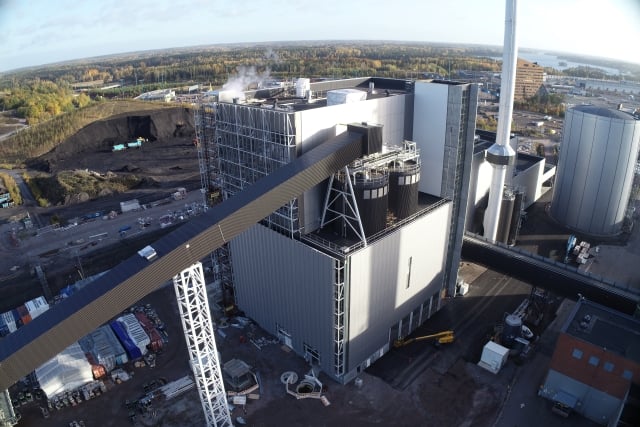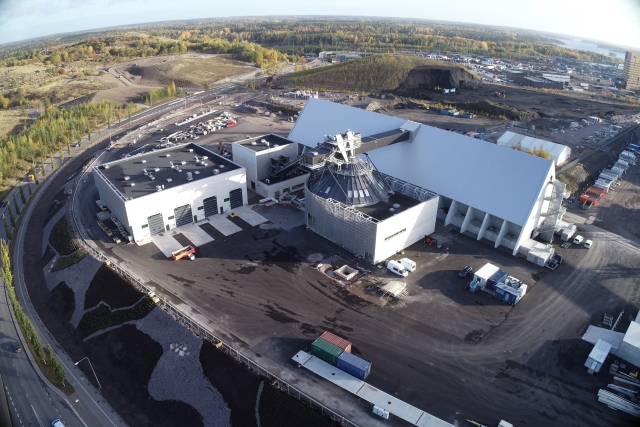Vuosaari bioenergy heating plant
We are phasing out the use of coal and aiming for carbon neutral energy production by 2030. The Hanasaari coal-fired power plant was closed on 1 April 2023 and the Salmisaari coal-fired power plant will be closed in April 2025. The heat production of the power plants will be replaced by recycling excess heat with heat pumps, by heat storage and with biomass.

The bioenergy heating plant is a new addition to the Vuosaari power plant area
The new bioenergy heating plant in Vuosaari is located north of the existing natural gas power plants which were commissioned in the 1990s. The district heat output of the bioenergy heating plant is approximately 260 MW. It will not produce electricity, but the plant can be modified into a combined district heat and power production plant by investing in a separate turbine plant.
The design of the plant has therefore been based on its versatility for various future needs, enabling the utilisation of e.g. P2X technologies in the future. The new plant will produce about a quarter of the district heat energy in the entire city of Helsinki, balancing the price variations of heat energy.

Top-notch energy efficiency
The energy efficiency of the new bioenergy heating plant has been taken to the highest level, and the minimum temperature of the flue gas it produces is about 11 degrees when it leaves the stack. The heat recovery of flue gases after the boiler can be maximised, and almost all of the water vapour contained in them is condensed with the aid of a separate heat recovery plant.
The selected solutions make the Vuosaari bioenergy heating plant possibly the most energy-efficient combustion plant in Finland. Water vapour accounts for less than 1% of the flue gas mass leaving the stack, and the utilisation of the entire plant calculated according to the method used in the EU is a whopping 122%.

The carbon-neutral plant is an important part of the energy mix in Helsinki
The Vuosaari bioenergy heating plant supports our journey towards carbon-neutral energy production. It will replace the production of the Hanasaari coal-fired power plant, which was closed in spring 2023, and the Salmisaari coal-fired power plant, which is to be closed in spring 2025. It is part of the distributed energy system where heat is produced from energy that is recovered from the ground, air, water, and waste heat. The plant will reduce carbon dioxide emissions by 700 tonnes per year.
Our operations respect biodiversity, aiming for long-term net positivity. The main fuel of the Vuosaari bioenergy heating plant is wood chips obtained as a by-product of forestry that cannot be utilised in other ways. The fuel we purchase has either a sustainability certification or it comes from otherwise controlled sources.
Questions about the Vuosaari bioenergy heating plant
We are phasing out the use of coal and aiming for carbon neutral energy production by 2030. Heat production in the Hanasaari and Salmisaari coal-fired power plants will be replaced with large-scale recycling of energy with heat pumps, heat storage and biomass. The Vuosaari bioenergy heating plant is the last part of the heat capacity that will replace the production of the Hanasaari power plant, meeting more than half of the plant’s heat production.
The Vuosaari bioenergy heating plant will replace about a quarter of the coal use of the closing Hanasaari power plant. Heat production will also be replaced with heat pumps and storage. The plant will account for about 15% of Helen’s fuel consumption.
Hanasaari will not be replaced totally with biomass. In addition to the bioenergy heating plant, heat production will be replaced with other production: recycling of energy with heat pumps and with energy storage. The efficiency of current capacity will also be intensified.
In Finland, bioenergy is mainly based on various sidestreams of forestry and the forest industry. Finland has a dynamic forest industry, so there will certainly be enough sidestreams available. The technical harvesting potential of wood chips and thinning backlogs amount to more than is currently carried out. An increase in demand will have an impact on the price of bioenergy but, on the other hand, unprofitable harvesting sites will then become lucrative and supply will increase. Our procurement area is the entire Baltic Sea region, and therefore we are not completely dependent on domestic supply.
We aim for sustainability in 100 per cent of our procured biomass. In practice, this means that the wood fuels we procure come from certified suppliers (e.g. PEFC, FSC or SBP) and from controlled sources.
We require that the production of our fuel suppliers takes into account sustainable forestry and biodiversity. We recognise the significance of deadwood to biodiversity in production forests, and we know the key principles of maintaining and producing deadwood.
Energy wood is not grown separately in Finnish forests, and therefore fractions used for energy are by-products of logging, forest management, and the sawmill and forest industries. Wood chips are produced from the by-products of logging, such as from branches and small-diameter thinnings. By-products of the forest industry include e.g. wood bark and sawdust, while circular economy fractions include, for example, reclaimed and demolition wood.
In biomass procurement, we aim to utilise domestic procurement sources as much as possible. In addition, procurement is also supplemented with imports, if necessary. We report the origin of the fuel we procure in our annual sustainability report.
Sustainably produced bioenergy is regarded as carbon neutral because its burning releases the same amount of carbon dioxide as the biomass has bound during its growth. Therefore, carbon dioxide circulates between the atmosphere and biomass, such as trees.
Treating biomass as having zero emissions is not Helen’s own practice, but it is agreed jointly and globally in the UN climate agreement. The zero emissions of biomass in energy production is based on EU-level legislation, e.g. the Emissions Trading Act and the Renewable Energy Directive. The idea of Europe-wide emissions trading is that the number of emission allowances used by industry is limited and their numbers will be reduced over time in accordance with the climate targets.
According to legislation, biomass is therefore regarded as emission-free in emissions trading. The calculation of the emissions of plants included in emissions trading is supervised by the Energy Authority.
The carbon dioxide emissions of biomass are, however, not disregarded when calculating total emissions. They are included, e.g. in the monitoring of the Paris Agreement and the emissions balance sheet of the countries. For the sake of clarity, all emissions of biomass are calculated in the so-called LULUCF sector, i.e. the land use, land use change and forestry sector. In practice, when a tree is felled in a forest, it is recorded in the statistics as an emission in its entirety, regardless of how and in what sector the tree and its various parts are utilised.
The use of biomass therefore has an impact on Finland’s net emissions but, to avoid duplicate calculation, the emissions of forest biomass are calculated in the land use sector, not in the energy sector.
Our current estimate is that about 60 truckloads of fuel are needed for the Vuosaari biofuel heating plant per day (excluding Sundays) when the power plant is operating at full power. Pre-crushed biofuels are brought to the plant area by truck via Ring III and the harbour road of Vuosaari. The amount of traffic will grow by about 1%. The emissions of transport are estimated to be a few per cent of the lifecycle emissions of the fuel. In exceptional situations, it is also possible to drive to the area via Niinisaarentie.
Construction of the Vuosaari bioenergy heating plant started with earthmoving works in March 2020 in accordance with the investment decision of Helen’s Board of Directors.
The price of district heat will not rise as a result of the investment in the Vuosaari bioenergy heating plant. The taxation of coal and natural gas has been raised over the past few years and the price of emission allowances has also increased, having an upward effect on the price of district heat. In heat production, biofuels are currently a competitive alternative in comparison with coal and natural gas.
In the Vuosaari bioenergy heating plant, flue gas cleaning is implemented in accordance with the BAT conclusions (Best Available Techniques) for large combustion plants applied throughout the EU. The BAT conclusions determine that the best flue gas cleaning techniques available on the market must be used in reducing emissions produced in the combustion plant.
In the Vuosaari bioenergy heating plant, biomass is burned in a circulating fluidized bed, i.e. CFB boiler, which is one of the most suitable boiler technologies for burning biomass of variable quality. The generation of primary emissions is minimised with a boiler technology suitable for biomass. The combustion air feed and the furnace temperature are constantly adjusted with the aid of an automation system to ensure that burning always takes place in optimal conditions. This way, the production of carbon monoxide, hydrocarbons, PAH compounds and unburned (black) carbon can be minimised.
Dust emissions created in combustion are filtered from flue gases with the aid of a bag filter. In the bag filter, flue gases are directed through extremely fine filter fabric hoses, trapping the dust and allowing the clean gas to pass through. After the bag filter, flue gases cleaned of dust are directed to the flue gas scrubber where heat is recovered from the flue gas into the district heating network through condensing. In the flue gas scrubber, the remaining impurities are dissolved in the water in addition to the heat. After the scrubber, the cleaned gas is conducted into the stack that releases almost emission-free flue gas. The emissions of the Vuosaari bioenergy heating plant are monitored with continuous measurements in the stack.
The condensate and waste water produced in the flue gas scrubber are utilised in full and cleaned in the bioenergy heating plant’s own water treatment plant to such a high degree that the water can be used as extra water in the district heating network and as boiler water.